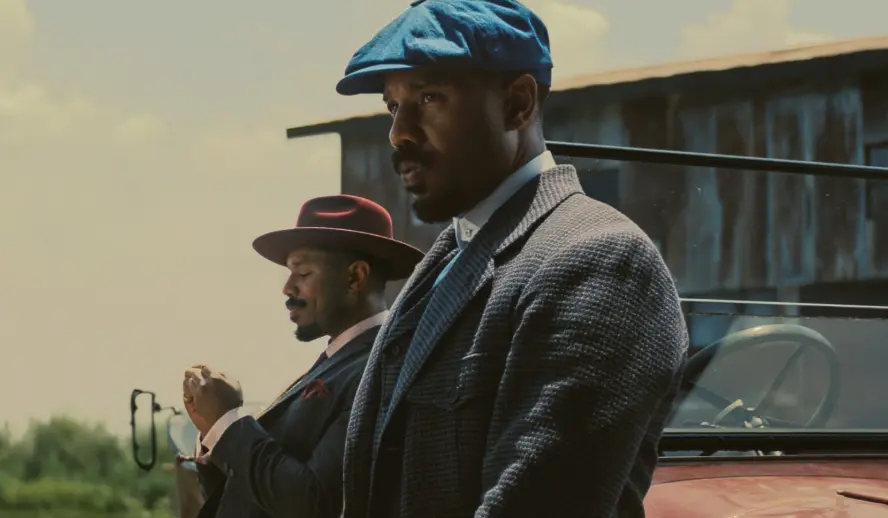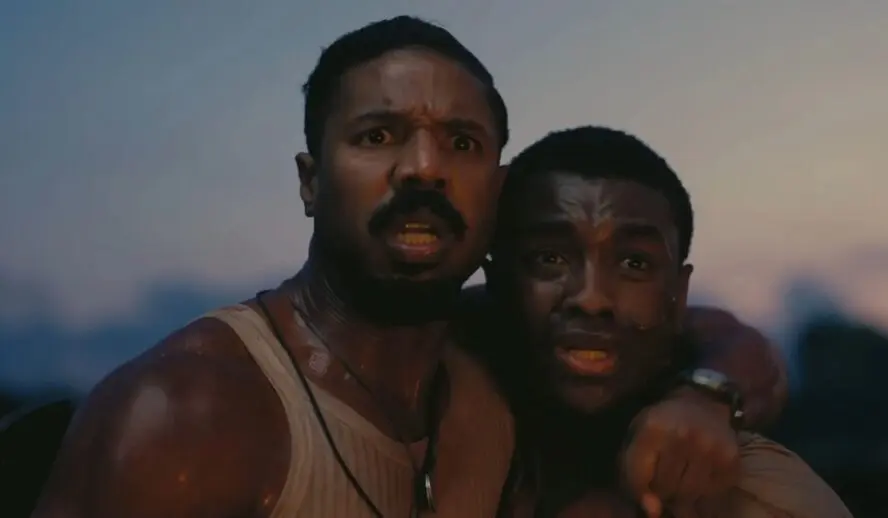
Ryan Coogler returns with ‘Sinners’, a genre-bending descent into fear, faith, and identity that reclaims horror as a site for Black storytelling. With Michael B. Jordan delivering his most commanding performance yet, Coogler advocates for the power of theatrical cinema and the future of Black genre filmmaking. Ryan Coogler’s newest venture, ‘Sinners,’ is nothing short of a resurrection. Blending operatic horror with socially resonant period storytelling, the film threads together hauntingly beautiful visuals, musical grandeur, and a sobering critique of the trauma of the Jim Crow South. With ‘Sinners,’ Coogler brings back a familiar team to reassert his position as one of the most visionary young directors working today, while marking a daring new direction in the Black horror sphere.
Things to do:
- Subscribe to The Hollywood Insider’s YouTube Channel, by clicking here.
- Limited Time Offer – FREE Subscription to The Hollywood Insider
- Click here to read more on The Hollywood Insider’s vision, values and mission statement here – Media has the responsibility to better our world – The Hollywood Insider fully focuses on substance and meaningful entertainment, against gossip and scandal, by combining entertainment, education, and philanthropy.
A Haunted Jim Crow South
Set in the Mississippi Delta during the summer of 1932, ‘Sinners’ tells the story of twin brothers Elijah “Smoke” and Elias “Stack” (both played impeccably by frequent Coogler collaborator Michael B. Jordan), who return to their hometown to open a lavish juke joint. What begins as a slow-burn examination of a diverse Deep South community and its residents’ search for catharsis quickly spirals into a harrowing confrontation with a clan of white vampires posing as folk musicians, the ghosts of Jim Crow sporting banjos and drooling blood.
Ryan Coogler delivers a feverish epic, a beautiful ode to Black music and resilient culture, all the while making it sexy, sinister, and spiritual. ‘Sinners’ is as much about the terrors of racism as it is about the resilience of Black and POC communities in America, the seduction of power, and the thin line between salvation and damnation.
WATCH THE TRAILER of the Film and the Revolution: ‘Can I Go Home Now?’
The Children Around the World Continue to Ask the question
Horror in Sharp 65mm
Set in 1932 Mississippi, ‘Sinners’ pulls out all the stops for period filmmaking. Collaborating with DP Autumn Durald Arkapaw, ‘Sinners’ receives a grandeur rarely seen in horror due to its 65mm IMAX format. Sweeping landscapes of cotton fields, swampy warm juke joints, and rustic southern towns gleam with texture and depth. Lit for Black skin, the frame glows with deep blues and rich golds. The aspect ratio of the film creatively shifts at key moments, heightening drama and drawing attention to the growing claustrophobia of our ensemble’s impending doom. The sun becomes a ticking time bomb, beautifully illuminating the symbol of Black servitude, setting into the darkness that brings out monsters. Arkapaw and Coogler visualize the “sun down town”: as darkness encroaches, none of our main characters are safe.
The production design of the film is impeccable. The juke joint itself is a vibrant, decadent haven for blues, booze, and Black life. Period-accurate signage indicates segregated spaces, and Chinese-owned stores ground the story in the historical realism of the real diaspora of Chinese immigrants into the Delta. The costuming of the characters, mainly the deep reds for the impulsive Stack and icy blues for the shyer Smoke, marks the twins’ complementary yet differing nature. Hailee Steinfeld’s Mary dons an innocent-seeming pink silk dress that, under the lights of the juke joint, melts into a sexy, seductive look.
The sound design is as layered as the visuals. From the twang of guitar strings to the shriek of vampire screams, every detail is precise and complements the incredible score. The bass rips through the theater, like incoming footsteps.
Related article: – Want GUARANTEED SUCCESS? Remove these ten words from your vocabulary| Transform your life INSTANTLY
Related article: The Compelling History of Black Horror Films Showcases Cultural Significance – Hollywood Insider
Between Heaven and Hell Lies the Delta
The film opens with its end: Sammie, nicknamed Preacher Boy (played by newcomer Miles Caton), arrives at the door of a church, bloodied, panting, and clutching a guitar neck, its body broken off. The doors fly open, and Preacher Boy pants as the congregation stares at him in horror.
A day earlier, Smoke and Stack slide back into the Delta, the twin mobsters return from Chicago with plans to give back to their community (or make more money?) with a new nightclub. They pick up their cousin, Preacher Boy, as well as the always drunk but ever-charming Delta Slim, played by the incomparable Delroy Lindo, to recruit them for their musical talents. Stack encounters his ex-girlfriend Mary, who angrily demands an explanation for his abandoning her seven years prior. Hailee Steinfeld commands the screen as Mary, the audience does not know whether she is to be trusted. Smoke solemnly visits his own home, mourns at the grave of his stillborn child, and reunites with his ex-wife, Annie (Wunmi Mosaku). As the club opens to the public, the community pours their wares, talents, and effort into getting it up and running.
As the club opens, Preacher Boy’s music transcends. Preacher Boy’s voice and his Dobro Cyclops guitar become a magical conduit. Caton’s deep, silky voice is pure perfection, and his vocals quite literally “pierces the veil between life and death.” This euphoria is short-lived, as vampires descend on the club. Led by Irish-born Remmick (Jack O’Connell), the white vampires are colonist creatures who seek to co-opt Black culture and control its creators. The trio of vampires are given more depth by their Irish heritage, as folks who most likely fled from Christian colonization in the area at the time, reflecting the vicious cycle of colonial violence.
The Show-Stopping Musical Sequence: A Black Mythology
The musical sequence at the center of ‘Sinners’ has been widely discussed online, and for good reason. It is a showstopping Coogler set-piece, the camera floating through steamy bodies and musical eras. As Preacher Boy belts, Black musicians from every period, from centuries-old tribal African drummers to a Slash-esque 1980s electric guitarist, enter the scene. The ambitious one-shot erupts into a mythic montage, past, present, and future colliding. Gospel singers, rappers, breakdancers, and Black folk musicians create a sultry, sacred moment. There are also ancient Chinese dancers present, reflecting a cultural symbiosis within the Delta and unity between oppressed groups. Here, Coogler crafts a new Black mythology. He reminds us that Black music is the tenant of American musical culture, that communal musical experiences have been a way for Black people to resist their oppression and experience joy. It is joy and grief braided together, as terror looms outside the sanctified walls of the club.
What follows is a terrorizing, action-filled battle between vampire and mortal. The last people standing must rely on Annie’s knowledge of vampirism, including their rejection of garlic and silver, and their need to be invited in to attack, in order to survive their ordeal. Preacher Boy must shatter his guitar to kill a vampire. Stack is turned into a vampire by Mary, who used her whiteness to attempt to shoo away the Irish folk singers. This cataclysmic, bloody, well-choreographed action deserves to be seen in a theater, on massive 65mm, the sound shaking your seat.
Related article: EVOLUTION: Every Ryan Gosling Role From 1995 to 2020, All Performances Exceptionally Poignant
Related article: EVOLUTION: Every Henry Cavill Role From 2001 to 2021, All Performances Exceptionally Poignant
Related article: ‘Dickinson’ Season 2 Delves Deeper Into the Life of the Legendary Poet Starring Hailee Steinfeld – Hollywood Insider
From Fruitvale Station, to the Ring, to Wakanda, to the Delta
Coogler has always been obsessed with legacy and has used his rising star to spotlight Black stories and make heroes of Black people. From the brutal police violence of Fruitvale Station, wherein victim Oscar Grant is given 90-minutes to breath and live again after his real-life murder, to the intergenerational trauma and brilliant action of the Creed trilogy, to Black Panther’s Afro-utopian vision, his protagonists are young Black men caught in systems they did not build, but must navigate.
With Sinners, Coogler turns his attention to the past for the first time– not for the sake of nostalgia, but because of unfinished business He mixes period drama and horror to dramatize the myths Black people were told about the end of slavery and the freedom of Jim Crow, and the way they did everything to fight back. He borrows from Westerns, musicals, and even classical vampire films, remixing them with something wholly new and deeply sociological.
Black Horror, Reinvented
‘Sinners’ is a welcome addition to the growing Black horror renaissance, but is of a grander scale than that of ‘Get Out’ or ‘His House,’ representing the growing power of Black auteurs to demand large budgets for genre work. Coogler demanded ownership of the film’s rights to return to him in 25 years, a deal only pulled off by household names like Tarantino. The box office success of the film represents the still-present power of creative, non-IP horror projects. Black audiences are often under-predicted for box office success, leading prognosticators to grossly underestimate the success of ‘Black Panther’ in 2018.
The film is a challenging allegory, yet it continues to draw crowds, spark debate, and intrigue. ‘Sinners’ dives headfirst into Black spirituality and African lore. The vampires are not just metaphors, but bloody, sexy, and surreal colonizers. Remmick does not just desire blood; he desires to steal music, disrupt culture, and retake land.
‘Sinners’ is also a blast. There is something feral about Jordan’s portrayal of Stack, something chaotic in the way Coogler lets his vampires party before they kill. Everyone is guilty of a little heathenry here, a very relatable message to audiences.
Related article: Understanding the Star Wars Timeline
Related article: A Tribute to Francis Ford Coppola: One of Cinema’s Unforgettable Directors | ‘Megalopolis’, ‘The Godfather’ & More
Related article: #metoo Revolution: Powerful Questions That Need Answers
Related article: FACT-CHECKED Series: Timothee Chalamet and 32 Facts about The Young Superstar
Related article: ‘The Harder They Fall’: A Black-Led Western Revenge Film – Hollywood Insider
Blues as Battle Cry
Ludwig Göransson’s score is monumental. Previously working on the ‘Black Panther’ and ‘Creed’ franchises with Coogler, Göransson reaches new heights on ‘Sinners,’ crafting a transcendent medley of Delta blues, Irish folk, metal, gospel, and trembling bass. The music functions as a second script; many of the film’s key revelations are revealed through the script, the score being choreographed to the tempo of the dialogue delivered.
Preacher Boy’s guitar summons ghosts. Pearline’s (Jayme Lawson) vocals seduce the undead. A musical motif rooted in Robert Johnson’s lore as a formative blues musician of the early 1900s appears every time a deal is struck. The final sequence turns into a full-blown Afro-sonic exorcism, explosive electric guitar riffs extenuating the deep twang of the country score.
Göransson recorded much of the score using period instruments and techniques, integrating the cast’s vocal and live performances. The sound is raw, holy, haunted, and unforgettable.
Related article: Top 10 South Park Characters | Who Makes the Cut? Kenny, Chef, Butters, Towelie, Eric?
Related article: In-Depth Analysis | The Unexpected Queerness of ‘Bob’s Burgers’: Why the Show is an Animated Ally
Related article: Female R&B Artists and Female Rappers Are Dominating the Charts – Hollywood Insider
The Women of ‘Sinners’
Hailee Steinfeld’s Mary is a revelation. As a biracial, white passing woman caught between two worlds, her performance is sultry, smart, and stingingly bitter. She’s no damsel, she is the story’s spark. Her nuanced relationship with Stack is as sexy as it is tragic, their undying affection for each other causing their demise.
Li Jun Li’s performance as the town’s Chinese shopkeeper, Grace Chow, adds crucial depth and texture to the historical epic. She helps the community of Black people who cannot get into white only stores, while the Chinese were often shut out from both White and Black only stores. She cares deeply for her family and is filled with righteous rage when the vampires threaten her daughter. Her final act of defiance, setting a vampire on fire, is one of the film’s boldest and most tragic moments, as the fire consumes her too.
Wunmi Mosaku’s Annie grounded the film in Black spirituality and heart. Her traditions, often dismissed by men, become the group’s salvation. Her scenes with Smoke are tender and powerful. Coogler casting Mosaku, a dark-skinned, full-figured woman as his love interest and spiritual leader, rejects Hollywood norms and is a welcome step forward in filmic representation.
Related article: In-Depth Analysis | The Unexpected Queerness of ‘Bob’s Burgers’: Why the Show is an Animated Ally
Related article: EVOLUTION: Every Chris Evans Role From 1997 to 2020, All Performances Exceptionally Poignant
Related article: With ‘His House’, Netflix Delivers a Compelling Immigrant Horror Story – Hollywood Insider
Horror as History, Horror as Hope
In ‘Sinners,’ to become a vampire is to be free of sun-soaked labor, to avoid death and maybe live into an era beyond oppression, but at what cost? Smoke, Stack, Sammie, and the women they love all face the same question: Is survival enough if it means losing your soul, making a deal with the devil?
The mid-credits scene reveals that Stack and Mary have lived as vampires into the 1990s. They visit an aged Sammy at his club, seeing him playing a beautiful medley on stage. They offer him a deal: an eternal life of music. Sammie refuses, admitting that that climactic night was the best and worst of his life. He asks Stack if his last day as a mortal was the best day of his life, too. “It was the last time I saw my brother,” Stack laments, “it was the last time I saw the sun.”
‘Sinners’ is a film about the oppression placed on Black people, the remedies they are forced to consider, and the joy they maintain anyway. It’s about the price of freedom under white supremacy, the temptation of capitalistic power, and the deep roots of music, memory, and blood. In every sense, ‘Sinners’ is a symphony.
By Leeann Remiker
Click here to read The Hollywood Insider’s CEO Pritan Ambroase’s love letter to Cinema, TV and Media. An excerpt from the love letter: The Hollywood Insider’s CEO/editor-in-chief Pritan Ambroase affirms, “We have the space and time for all your stories, no matter who/what/where you are. Media/Cinema/TV have a responsibility to better the world and The Hollywood Insider will continue to do so. Talent, diversity and authenticity matter in Cinema/TV, media and storytelling. In fact, I reckon that we should announce “talent-diversity-authenticity-storytelling-Cinema-Oscars-Academy-Awards” as synonyms of each other. We show respect to talent and stories regardless of their skin color, race, gender, sexuality, religion, nationality, etc., thus allowing authenticity into this system just by something as simple as accepting and showing respect to the human species’ factual diversity. We become greater just by respecting and appreciating talent in all its shapes, sizes, and forms. Award winners, which includes nominees, must be chosen on the greatness of their talent ALONE.
I am sure I am speaking for a multitude of Cinema lovers all over the world when I speak of the following sentiments that this medium of art has blessed me with. Cinema taught me about our world, at times in English and at times through the beautiful one-inch bar of subtitles. I learned from the stories in the global movies that we are all alike across all borders. Remember that one of the best symbols of many great civilizations and their prosperity has been the art they have left behind. This art can be in the form of paintings, sculptures, architecture, writings, inventions, etc. For our modern society, Cinema happens to be one of them. Cinema is more than just a form of entertainment, it is an integral part of society. I love the world uniting, be it for Cinema, TV, media, art, fashion, sport, etc. Please keep this going full speed.”
More Interesting Stories From The Hollywood Insider
– Want GUARANTEED SUCCESS? Remove these ten words from your vocabulary| Transform your life INSTANTLY
– A Tribute to Martin Scorsese: A Complete Analysis of the Life and Career of the Man Who Lives and Breathes Cinema
– Do you know the hidden messages in ‘Call Me By Your Name’? Find out behind the scenes facts in the full commentary and In-depth analysis of the cinematic masterpiece
– A Tribute To The Academy Awards: All Best Actor/Actress Speeches From The Beginning Of Oscars 1929-2019 | From Rami Malek, Leonardo DiCaprio To Denzel Washington, Halle Berry & Beyond | From Olivia Colman, Meryl Streep To Bette Davis & Beyond
– In the 32nd Year Of His Career, Keanu Reeves’ Face Continues To Reign After Launching Movies Earning Over $4.3 Billion In Total – “John Wick”, “Toy Story 4”, “Matrix”, And Many More
____________________________________________________________________________









